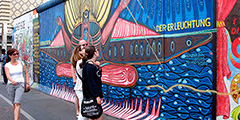The East Side Gallery is an international monument to freedom and hope. It was created on a section of the east side of the Berlin Wall by artists from around the world.
The East Side Gallery came about after the fall of the wall in 1990 as the first project between East and West German arts organisations. More than one hundred artists from twenty-one countries began to paint the 1.3 kilometre strip of wall on Mühlenstraße. This section of the eastern part of the wall which was once grey is now colourful. It has been under preservation order since 1991. There are more than one hundred paintings about overcoming the East-West divide, critically reflecting the political upheaval of the years 1989-1990 from a variety of perspectives. They mirror hopes of peace and a future together without a dividing wall.
After so many years, several of the paintings were in need of renovation so in 1997 the Artists Initiative East Side Gallery e.V. was founded to carry out restorations and save the murals from the effects of car emissions, graffiti and weathering. To coincide with the twentieth anniversary of the fall of the wall, public funding was made available to the organisation for the restoration of the East Side Gallery. Differences arose among the artists as to how the money was to be used, and several pictures are therefore no longer on display. This painted wall has become a Berlin landmark. Every year tens of thousands of tourists visit the East Side Gallery, which has evolved into a commercial enterprise.
Hope for peace and a future together without a dividing wall
Some of the artists have objected to the fact that they had no share in the proceeds and for that reason have painted over their pictures. In the past few years, segments of the wall have been removed from the gallery to facilitate building projects, notably drawing heavy protest from the public in 2013.
Located in a place where up to 1989 East was separated from West and where people died attempting to cross the border, the wall has become a memorial to reconciliation, understanding between peoples, and peace. The East Side Gallery celebrates hope, new-found freedom and the joy of overcoming division. However, it is also a place of great controversy regarding how public memory may be presented and who has a part in it.
Food for thought: Which visible and invisible walls exist in our society and in our minds?






 5 minutes
5 minutes